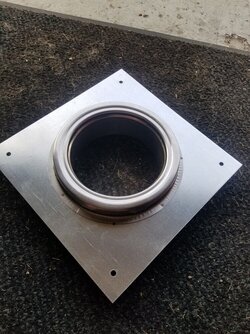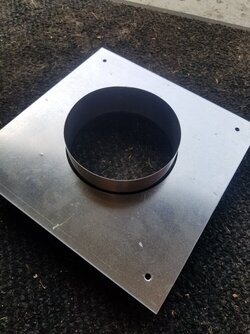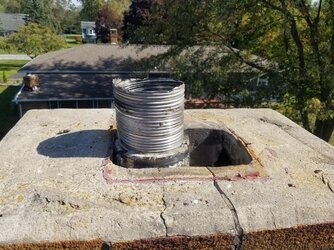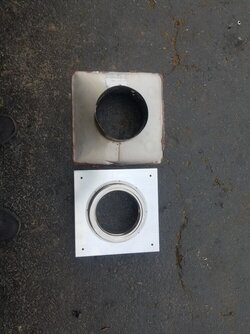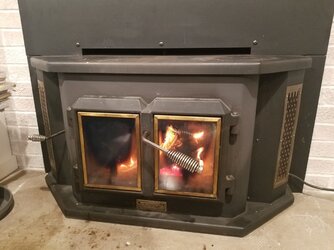If 3 feet is sufficient will 6 feet be detrimental to the operation of the stove? I dont see it hurting anything but these questions are also why I am here.I do cheap single wall extensions as a test all the time.
Help extending chimney flue.
- Thread starter Freehaetisgood
- Start date
-
Active since 1995, Hearth.com is THE place on the internet for free information and advice about wood stoves, pellet stoves and other energy saving equipment.
We strive to provide opinions, articles, discussions and history related to Hearth Products and in a more general sense, energy issues.
We promote the EFFICIENT, RESPONSIBLE, CLEAN and SAFE use of all fuels, whether renewable or fossil.
You are using an out of date browser. It may not display this or other websites correctly.
You should upgrade or use an alternative browser.
You should upgrade or use an alternative browser.
There is no way for me to know if height is even the issueIf 3 feet is sufficient will 6 feet be detrimental to the operation of the stove? I dont see it hurting anything but these questions are also why I am here.
Well if you had a stove that ran great the way it's currently setup. Would adding 3 feet of flue to to said setup be detrimental to the stoves operation?There is no way for me to know if height is even the issue
It's doubtful that it would hurt but I would extend with a cheap piece of pipe firstWell if you had a stove that ran great the way it's currently setup. Would adding 3 feet of flue to to said setup be detrimental to the stoves operation?
Because this pipe will be sitting on that flange alone even if it's only 3 feet tall I will be bracing it. We get 70+ mph winds here from the south west and I have a good size open field behind my house. So it will be braced regardless.You will need to add bracing if going over 5 feet above the roof.
Ok you guys talked me into just installing one three foot section of pipe for time being. It wont be hard to add a second piece later if need be. I got up on my roof thismorning and noticed my chimney cap is slightly crowned. I guess il have to add some mortor or such to get the area this adaptor plate needs to mount flat. I'm going to pull the other flue cap off and am seeking some advice on getting the chimney ready to install the adaptor plate. Any suggestions?
Last edited:
Ok guys I have figured out how to get the adaptor plate setup so I'm all good ther. One thing I'm curious about is if my stove should have a grate at the bottom to hold the wood while burning? I cant find much info on my stove but it is designed for secondary combustion wich makes me think it should. It is an old russo insert.
No it should not. I didn't know any Russo stoves had secondary combustion. Any pics of it out of curiosityOk guys I have figured out how to get the adaptor plate setup so I'm all good ther. One thing I'm curious about is if my stove should have a grate at the bottom to hold the wood while burning? I cant find much info on my stove but it is designed for secondary combustion wich makes me think it should. It is an old russo insert.
Ok yeah that's really just a very primitive air wash not secondary combustionI posted a pic a few years ago and explained how when I took the windows out for cleaning I noticed there was washers between the window frames and the stove. I asked if someone put them there by accident and someone said " dont remove them as they are there for secondary combustion"
View attachment 316768
The primary damper actually has a piece of thick steel that directs the intake air to the windows also. Seems like a lot of window wash no?. Also I feel with the windows being able to take in air it takes away from some of my control of the burn. Do you think I can remove washers so windows dont allow airflow?Ok yeah that's really just a very primitive air wash not secondary combustion
On a stove like yours it's not going to matterThe primary damper actually has a piece of thick steel that directs the intake air to the windows also. Seems like a lot of window wash no?. Also I feel with the windows being able to take in air it takes away from some of my control of the burn. Do you think I can remove washers so windows dont allow airflow?
Please explain.There's no need to extend the flue for the old insert. It will not improve operation.
I cant see why? With the stove drawing air in around the windows it doesnt need to draw through the adjustable damper on the bottom. Idk how this is as I figured oxygen at the base of the fire was essential to keep a good fire. I must have a lot to learn here. So you dont need oxygen at the bottom of the fire?On a stove like yours it's not going to matter
No it's not a coal fire you don't need air at the base for wood at all.I cant see why? With the stove drawing air in around the windows it doesnt need to draw through the adjustable damper on the bottom. Idk how this is as I figured oxygen at the base of the fire was essential to keep a good fire. I must have a lot to learn here. So you dont need oxygen at the bottom of the fire?
ok. So if I close the damper that let's air hit closer to the bottom of the fire why does the fire start to fade? Surely there is plenty of air coming in around the windows to keep it going. Even a hot small fire acts the same way.No it's not a coal fire you don't need air at the base for wood at all.
There may not be enough air coming around the windows I don't know I have never run one of these stoves. What moisture content is your wood at?ok. So if I close the damper that let's air hit closer to the bottom of the fire why does the fire start to fade? Surely there is plenty of air coming in around the windows to keep it going. Even a hot small fire acts the same way.
I basically stopped running this stove a couple years back because I was sick of this issue. I couldn't now tell you the moisture content of the wood I was burning 3 to 5 years ago. I can however tell you pulling from the same wood pile day after day back then somtimes the stove would run great for 2 days without a single hiccup. Then there could be days that starting a fire was just out of the question. Even pointing my torch with map gas to the back of the stove into the flue for 2 minutes in an attempt to get it going would still not help. This can go on for weeks then one day il open the stove and it is drafting and I fire it right up. It's like hit or miss. It seams to be effected by the wind. My one friend rebuilt chimneys for years. I told him my issue and he thinks the wind is coming over my second story and in a sense is cramming the air down my chimney. That would be wind out of the west. Normally wind comes from the southwest where I live so what he said made perfect sense to me. I fired this stove up today to get a reminder of the issues I had and get a reference point before I add my 3 foot section. I will most likely add it this coming week. Well today the stove fired right up and has been running good even though it is 50 degrees out. I went outside and looked at the chimney and realized the wind is coming from the east today. I then confirmed that with the weather channel.
Have you had a pro out to look things over?I basically stopped running this stove a couple years back because I was sick of this issue. I couldn't now tell you the moisture content of the wood I was burning 3 to 5 years ago. I can however tell you pulling from the same wood pile day after day back then somtimes the stove would run great for 2 days without a single hiccup. Then there could be days that starting a fire was just out of the question. Even pointing my torch with map gas to the back of the stove into the flue for 2 minutes in an attempt to get it going would still not help. This can go on for weeks then one day il open the stove and it is drafting and I fire it right up. It's like hit or miss. It seams to be effected by the wind. My one friend rebuilt chimneys for years. I told him my issue and he thinks the wind is coming over my second story and in a sense is cramming the air down my chimney. That would be wind out of the west. Normally wind comes from the southwest where I live so what he said made perfect sense to me. I fired this stove up today to get a reminder of the issues I had and get a reference point before I add my 3 foot section. I will most likely add it this coming week. Well today the stove fired right up and has been running good even though it is 50 degrees out. I went outside and looked at the chimney and realized the wind is coming from the east today. I then confirmed that with the weather channel.
I have not. I just took the advice my buddy gave me. He looked at it for one second and told me about the wind cramming the air down. He said it needs to be taller and my thinking was it's cheap enough to try. I guess he is a pro when it comes to chimneys but not wood burning stoves/inserts.Have you had a pro out to look things over?
So I did finish everything up a couple weeks back. I've prolly had a fire 7 or 8 times since adding that three foot extension. So far I gotta say it has worked wonders. This insert is like a while new stove. So far every time I've opened the stove there is a draft, even before starting a fire. No more wads of paper in there to smoke the house out while attempting to induce a draft. Even with a good west wind it fires up real nice. I actually think the stronger the wind from any direction the better my draft. Before it wasnt possible to even light this stove with the slightest west wind. It hasnt been super cold in western ny yet but we've been in the 30s a bunch of nights. Before I had to put tape around the windows on this stove to keep it from stinking out the house when it wasnt running. So far I havnt smelled the smallest hint of it since the extension. No tape needed ahha. Il give it another month to be positive that extension was an amazing addition. But so far I am convinced that was my issue all these years. Thos stove does crank out some heat. I might try to ge the fan a little quieter but its not really loud.
Similar threads
- Replies
- 4
- Views
- 471
- Replies
- 1
- Views
- 315
- Replies
- 23
- Views
- 2K
- Replies
- 4
- Views
- 617


